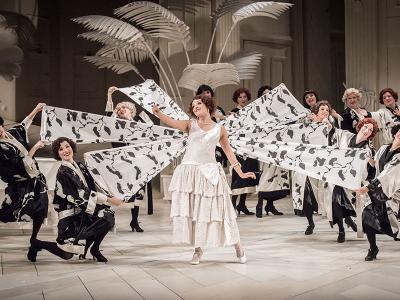What are the Savoy Operas?
The Savoy Operas were a new type of comic opera popularised in Victorian England. Here are some of the most famous Savoy Operas, as well as the history behind the revolutionary opera genre.
Savoy Operas were a new type of comic opera
Video
Savoy operas were a type of comic opera to emerge in the late 19th century. Its name simply comes from the theatre these new productions were premiered in – the Savoy.
Today, the Savoy theatre is better known for its musical theatre productions, but it was originally built in 1881 by English theatrical agent and composer, Richard D’Oyly Carte, to specifically house Gilbert & Sullivan’s comic operas. This made Gilbert and Sullivan the leading exponents of Savoy opera, as well as the first to venture into this new opera genre.
Gilbert and Sullivan Savoy Operas
Video
Gilbert and Sullivan composed around 13 Savoy operas for Richard D’Oyly Carte. This includes some of their most famous operas like HMS Pinafore, The Mikado, Trial by Jury and Iolanthe. All these operas followed a similar style. They were operettas which meant they were similar to a musical in that they were a combination of spoken word and opera songs, even being recognised as the basis of modern musicals you know today.
Video
They were also humorous and lighthearted, typically ending in a happy ending to follow the components of a standard comic opera.
However, towards the end of their partnership, Arthur Sullivan grew tired of composing comic operas, and instead wanted to return to grand opera – a more serious type of opera. This led to the creation of one and Gilbert and Sullivan’s darker Savoy operas, The Yeomen of the Guard.
How many Savoy Operas are there?
Video
In total, there are believed to be around 33 savoy operas. Outside of Gilbert & Sullivan’s significant contribution there were a number of other composers who took the helm, all of which were specifically curated for the Savoy theatre.
Basil Hood, a British dramatist, composed a series of Savoy operas including The Rose of Persia, The Emerald Isle and Merrie England. Arthur Sullivan also traded W.S. Gilbert for other partnerships, including working with Sydney Grundy on Haddon Hall and F.C. Burnand on The Chieftain.
However, none of these operas have stood the test of time as long as Gilbert & Sullivan’s works. That’s why over the years, Savoy operas have become synonymous with the operatic duo, with many of the other composers sadly not getting the recognition they deserve for their part in the opera movement.
Savoy Operas were also known as English operas
Video
Savoy operas are thoroughly intertwined with the history of English opera. So much so that they are also known as ‘English operas’. This is because they were not only performed in a brand new London theatre, but their plot and musical compositions were inherently British.
Savoy operas were often sung in English and created by English composers to compete with Italian opera which dominated at the time. Their stories also centred around English characters, particularly from history or members of royalty.
For example, Major-General Stanley in Gilbert and Sullivan’s Pirates of Penzance is said to be based on a real general, Sir Garnet Wolseley who was a popular character of his time. However, thanks to one of the most famous opera songs in the world, ‘The Major-General’s Song’, Wolseley’s popularity will live on forever as a firm fan favourite.


